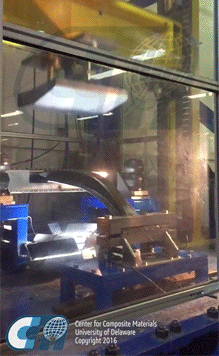U.S. Department of Transportation National Highway Traffic Safety Administration NHTSA Releases High Performance Computing Studies Report
Authors:
D. Heider, S. Yarlagadda, J.J. Tierney, B. Gama, N. Shevchenko, A. Yiournas, J.W. Gillespie Jr.,
Center for Composite Materials, University of Delaware
A. Campbell, L. Keuthage, D. Rinehardt,
BMW Group
D. Fulk, R. Myers,
National Center for Manufacturing Sciences
| UD-CCM in partnership with NCMS, NHTSA and BMW investigated thermoplastic carbon fiber reinforced materials for vehicle sideframe structures. The proposed B-pillar was designed to meet structural and crash safety requirements (e.g., FMVSS 214 barrier) using thermoplastic composites which offers significant advantages (e.g., recycling, joining, >60% elongation leading to improved ductility and energy absorption) compared to thermoset with the potential for improved crash performance. Novel side-impact crash concepts maximizing crash performance have been developed and commercial available thermoplastic materials were characterized to define appropriate material models and to evaluate energy absorption mechanisms. Predictive engineering at all levels, from coupon to sub-element to full-scale, guided the material down-selection. The same CAE tools simulate full vehicle to component and test setup behavior and were used to optimize manufacturability and structural/ crash performance. Sub-components and B-pillars have been fabricated using the stamp forming and infusion processes allowing scalability with the potential to meet automotive production rates in the future. UD-CCM’s large drop tower was used to validate the predictive engineering tools and crash performance of the proposed B-pillars under realistic side-impact crash conditions. The B-pillar design was spatially optimized for energy absorption (ductility), stiffness, and strength while maintaining part producibility and vehicle integration. BMW established B-pillar performance metrics derived from full-vehicle crash simulations and other design and integration requirements. UD-CCM provided full range of capabilities in materials selection and evaluation, composite design, analysis and crash simulations, |
 Click Here for Full Report |
process development and manufacturing (tooling, part production, trimming), full-scale pillar assembly and high-energy impact testing. This project has demonstrated design, materials, manufacturing and joining methods with continuous carbon fiber thermoplastics, at TRL 4-7 to meet automotive industry and government safety specifications.
Key achievements from this project include:
|
 |
- The impact test was simulated and compared to the experimental data (deflection, load, and others) validating the predictive engineering approach.
- Continuous carbon fiber thermoplastic composites are shown to exhibit improved ductility and energy absorption.
This effort has demonstrated design, materials, manufacturing and joining methods with continuous carbon fiber thermoplastics, at TRL 4-7 to meet automotive industry and government safety specifications.







